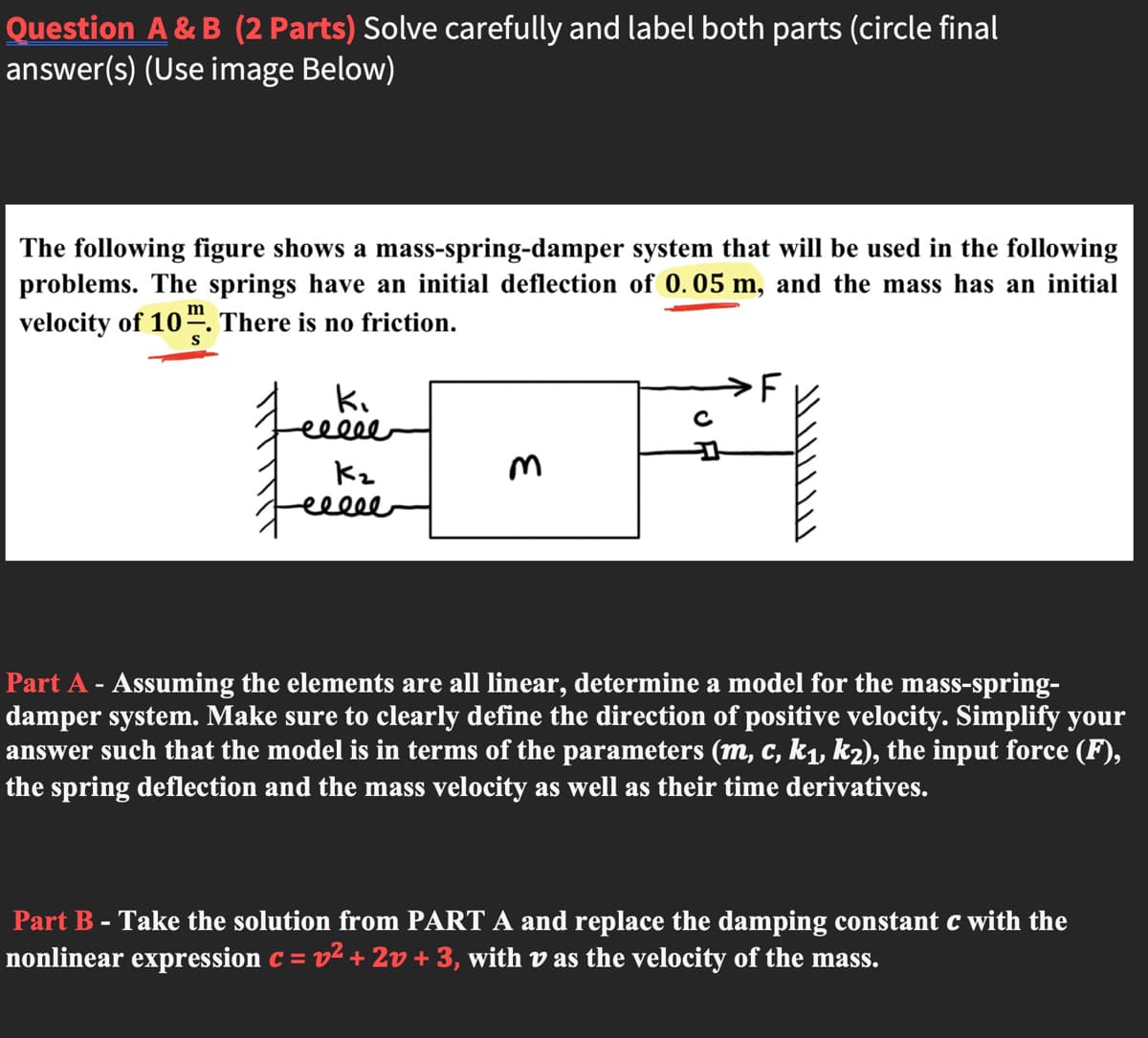Question A & B (2 Parts) Solve carefully and label both parts (circle final answer(s) (Use image Below) The following figure shows a mass-spring-damper system that will be used in the following problems. The springs have an initial deflection of 0.05 m, and the mass has an initial m velocity of 10". There is no friction. Kz eele Part A - Assuming the elements are all linear, determine a model for the mass-spring- damper system. Make sure to clearly define the direction of positive velocity. Simplify your answer such that the model is in terms of the parameters (m, c, k1, k2), the input force (F), the spring deflection and the mass velocity as well as their time derivatives. Part B- Take the solution from PART A and replace the damping constant c with the nonlinear expression c = v² + 2v + 3, with v as the velocity of the mass.
Question A & B (2 Parts) Solve carefully and label both parts (circle final answer(s) (Use image Below) The following figure shows a mass-spring-damper system that will be used in the following problems. The springs have an initial deflection of 0.05 m, and the mass has an initial m velocity of 10". There is no friction. Kz eele Part A - Assuming the elements are all linear, determine a model for the mass-spring- damper system. Make sure to clearly define the direction of positive velocity. Simplify your answer such that the model is in terms of the parameters (m, c, k1, k2), the input force (F), the spring deflection and the mass velocity as well as their time derivatives. Part B- Take the solution from PART A and replace the damping constant c with the nonlinear expression c = v² + 2v + 3, with v as the velocity of the mass.
Elements Of Electromagnetics
7th Edition
ISBN:9780190698614
Author:Sadiku, Matthew N. O.
Publisher:Sadiku, Matthew N. O.
ChapterMA: Math Assessment
Section: Chapter Questions
Problem 1.1MA
Related questions
Question
Use image below for problem statement

Transcribed Image Text:Question A & B (2 Parts) Solve carefully and label both parts (circle final
answer(s) (Use image Below)
The following figure shows a mass-spring-damper system that will be used in the following
problems. The springs have an initial deflection of 0.05 m, and the mass has an initial
velocity of 10-. There is no friction.
S
ki
F
Kz
eeeee
Part A - Assuming the elements are all linear, determine a model for the mass-spring-
damper system. Make sure to clearly define the direction of positive velocity. Simplify your
answer such that the model is in terms of the parameters (m, c, k1, k2), the input force (F),
the spring deflection and the mass velocity as well as their time derivatives.
Part B - Take the solution from PART A and replace the damping constant c with the
nonlinear expression c = v² + 2v + 3, with v as the velocity of the mass.
Expert Solution
Step 1
The mass displacement is proportional to the spring force. The viscous damping force is related to the mass's velocity. When a mass is deflected by a certain amount, forces are generated on both the spring and the damper. The theory of conservation of energy can be used to overcome such problems.
Trending now
This is a popular solution!
Step by step
Solved in 2 steps with 1 images

Knowledge Booster
Learn more about
Need a deep-dive on the concept behind this application? Look no further. Learn more about this topic, mechanical-engineering and related others by exploring similar questions and additional content below.Recommended textbooks for you

Elements Of Electromagnetics
Mechanical Engineering
ISBN:
9780190698614
Author:
Sadiku, Matthew N. O.
Publisher:
Oxford University Press

Mechanics of Materials (10th Edition)
Mechanical Engineering
ISBN:
9780134319650
Author:
Russell C. Hibbeler
Publisher:
PEARSON

Thermodynamics: An Engineering Approach
Mechanical Engineering
ISBN:
9781259822674
Author:
Yunus A. Cengel Dr., Michael A. Boles
Publisher:
McGraw-Hill Education

Elements Of Electromagnetics
Mechanical Engineering
ISBN:
9780190698614
Author:
Sadiku, Matthew N. O.
Publisher:
Oxford University Press

Mechanics of Materials (10th Edition)
Mechanical Engineering
ISBN:
9780134319650
Author:
Russell C. Hibbeler
Publisher:
PEARSON

Thermodynamics: An Engineering Approach
Mechanical Engineering
ISBN:
9781259822674
Author:
Yunus A. Cengel Dr., Michael A. Boles
Publisher:
McGraw-Hill Education

Control Systems Engineering
Mechanical Engineering
ISBN:
9781118170519
Author:
Norman S. Nise
Publisher:
WILEY

Mechanics of Materials (MindTap Course List)
Mechanical Engineering
ISBN:
9781337093347
Author:
Barry J. Goodno, James M. Gere
Publisher:
Cengage Learning

Engineering Mechanics: Statics
Mechanical Engineering
ISBN:
9781118807330
Author:
James L. Meriam, L. G. Kraige, J. N. Bolton
Publisher:
WILEY